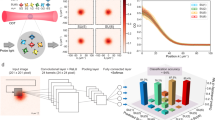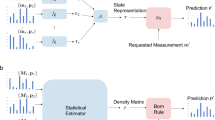Abstract
Machine-learning techniques such as artificial neural networks are currently revolutionizing many technological areas and have also proven successful in quantum physics applications1,2,3,4. Here, we employ an artificial neural network and deep-learning techniques to identify quantum phase transitions from single-shot experimental momentum-space density images of ultracold quantum gases and obtain results that were not feasible with conventional methods. We map out the complete two-dimensional topological phase diagram of the Haldane model5,6,7 and provide an improved characterization of the superfluid-to-Mott-insulator transition in an inhomogeneous Bose–Hubbard system8,9,10. Our work points the way to unravel complex phase diagrams of general experimental systems, where the Hamiltonian and the order parameters might not be known.
This is a preview of subscription content, access via your institution
Access options
Access Nature and 54 other Nature Portfolio journals
Get Nature+, our best-value online-access subscription
$29.99 / 30 days
cancel any time
Subscribe to this journal
Receive 12 print issues and online access
$209.00 per year
only $17.42 per issue
Buy this article
- Purchase on Springer Link
- Instant access to full article PDF
Prices may be subject to local taxes which are calculated during checkout



Similar content being viewed by others
Data availability
Source data for Figs. 2 and 3 are available in the Supplementary information. All data files including onnx files of the trained networks are available from the corresponding author on request.
References
Carrasquilla, J. & Melko, R. G. Machine learning phases of matter. Nat. Phys. 13, 431–434 (2017).
van Nieuwenburg, E. P. L., Liu, Y.-H. & Huber, S. D. Learning phase transitions by confusion. Nat. Phys. 13, 435–439 (2017).
Carleo, G. & Troyer, M. Solving the quantum many-body problem with artificial neural networks. Science 355, 602–606 (2017).
Gao, X. & Duan, L.-M. Efficient representation of quantum many-body states with deep neural networks. Nat. Commun. 8, 662 (2017).
Haldane, F. D. M. Model for a quantum Hall effect without Landau levels: condensed-matter realization of the “parity anomaly”. Phys. Rev. Lett. 61, 2015–2018 (1988).
Jotzu, G. et al. Experimental realization of the topological Haldane model with ultracold fermions. Nature 515, 237–240 (2014).
Fläschner, N. et al. Experimental reconstruction of the Berry curvature in a Floquet Bloch band. Science 352, 1091–1094 (2016).
Fisher, M. P. A., Weichman, P. B., Grinstein, G. & Fisher, D. S. Boson localization and the superfluid–insulator transition. Phys. Rev. B 40, 546–570 (1989).
Jaksch, D., Bruder, C., Cirac, J. I., Gardiner, C. W. & Zoller, P. Cold bosonic atoms in optical lattices. Phys. Rev. Lett. 81, 3108–3111 (1998).
Greiner, M., Mandel, O., Esslinger, T., Hänsch, T. W. & Bloch, I. Quantum phase transition from a superfluid to a Mott insulator in a gas of ultracold atoms. Nature 415, 39–44 (2002).
Lewenstein, M. et al. Ultracold atomic gases in optical lattices: mimicking condensed matter physics and beyond. Adv. Phys. 56, 243–379 (2007).
Bloch, I., Dalibard, J. & Zwerger, W. Many-body physics with ultracold gases. Rev. Mod. Phys. 80, 885–964 (2008).
LeCun, Y., Bengio, Y. & Hinton, G. Deep learning. Nature 521, 436–521 (2015).
Bakr, W. S. et al. Probing the superfluid-to-Mott insulator transition at the single-atom level. Science 329, 547–550 (2010).
Sherson, J. F. et al. Single-atom-resolved fluorescence imaging of an atomic Mott insulator. Nature 467, 68–72 (2010).
Ohtsuki, T. & Ohtsuki, T. Deep learning the quantum phase transitions in random two-dimensional electron systems. J. Phys. Soc. Jpn 85, 123706 (2016).
Ch’ng, K., Carrasquilla, J., Melko, R. G. & Khatami, E. Machine learning phases of strongly correlated fermions. Phys. Rev. X 7, 031038 (2017).
Broecker, P., Carrasquilla, J., Melko, R. G. & Trebst, S. Machine learning quantum phases of matter beyond the fermion sign problem. Sci. Rep. 7, 8823 (2017).
Huembeli, P., Dauphin, A. & Wittek, P. Identifying quantum phase transitions with adversarial neural networks. Phys. Rev. B 97, 134109 (2018).
Deng, D.-L., Li, X. & Das Sarma, S. Machine learning topological states. Phys. Rev. B 96, 195145 (2017).
Zhang, Y. & Kim, E.-A. Quantum loop topography for machine learning. Phys. Rev. Lett. 118, 216401 (2017).
Zhang, P., Shen, H. & Zhai, H. Machine learning topological invariants with neural networks. Phys. Rev. Lett. 120, 066401 (2018).
Zhang, Y. et al. Machine learning in electronic-quantum-matter imaging experiments. Nature https://doi.org/10.1038/s41586-019-1319-8 (2019).
Wigley, P. B. et al. Fast machine-learning online optimization of ultra-cold-atom experiments. Sci. Rep. 6, 25890 (2016).
Pyzh, M., Krönke, S., Weitenberg, C. & Schmelcher, P. Quantum point spread function for imaging trapped few-body systems with a quantum gas microscope. New J. Phys. 21, 053013 (2019).
Sorensen, J. J. W. H., Aranburu, M. O., Heinzel, T. & Sherson, J. F. Approaching the quantum speed limit with global-local optimization. Preprint at https://arxiv.org/abs/1802.07521 (2018).
Oka, T. & Aoki, H. Photovoltaic Hall effect in graphene. Phys. Rev. B 79, 081406(R) (2009).
Tarnowski, M. et al. Measuring topology from dynamics by obtaining the Chern number from a linking number. Nat. Commun. 10, 1728 (2019).
Hauke, P., Lewenstein, M. & Eckardt, A. Tomography of band insulators from quench dynamics. Phys. Rev. Lett. 113, 045303 (2014).
Aidelsburger, M. et al. Measuring the Chern number of Hofstadter bands with ultracold bosonic atoms. Nat. Phys. 11, 162–166 (2015).
Gemelke, N., Zhang, X., Hung, C.-L. & Chin, C. In situ observation of incompressible Mott-insulating domains in ultracold atomic gases. Nature 460, 995–998 (2009).
Becker, C. et al. Ultracold quantum gases in triangular optical lattices. New J. Phys. 12, 065025 (2010).
Teichmann, N., Hinrichs, D. & Holthaus, M. Reference data for phase diagrams of triangular and hexagonal bosonic lattices. Eur. Phys. Lett. 91, 10004 (2010).
Lin, Z., Zhang, J. & Jiang, Y. Quantum phase transitions of ultracold Bose systems in nonrectangular optical lattices. Phys. Rev. A 85, 023619 (2012).
Gerbier, F. et al. Phase coherence of an atomic Mott insulator. Phys. Rev. Lett. 95, 050404 (2005).
Thomas, C. K. et al. Mean-field scaling of the superfluid to Mott insulator transition in a 2d optical superlattice. Phys. Rev. Lett. 119, 100402 (2017).
Broecker, P., Assaad, F. F. & Trebst, S. Quantum phase recognition via unsupervised machine learning. Preprint at https://arxiv.org/abs/1707.00663 (2017).
Torlai, G. et al. Neural-network quantum state tomography. Nat. Phys. 14, 447–450 (2018).
Biamonte, J. et al. Quantum machine learning. Nature 549, 195–202 (2017).
Struck, J. et al. Quantum simulation of frustrated classical magnetism in triangular optical lattices. Science 333, 996–999 (2011).
Eckardt, A. Colloquium: atomic quantum gases in periodically driven optical lattices. Rev. Mod. Phys. 89, 011004 (2017).
Asteria, L. et al. Measuring quantized circular dichroism in ultracold topological matter. Nat. Phys. 15, 449–454 (2019).
Nielsen, M. A. Neural Networks and Deep Learning (Determination Press, 2015).
Goodfellow, I., Bengio, Y. & Courville, A. Deep Learning (MIT Press, 2017).
Mehta, P. et al. A high-bias, low-variance introduction to Machine Learning for physicists. Phys. Rep. 810, 1–124 (2019).
Lin, H. W., Tegmark, M. & Rolnik, D. Why does deep and cheap learning work so well? J. Stat. Phys. 168, 1223–1247 (2017).
Montavon, G., Samek, W. & Müller, K.-R. Methods for interpreting and understanding deep neural networks. Digit. Signal Process. 73, 1–15 (2018).
Sun, N., Yi, J., Zhang, P., Shen, H. & Zhai, H. Deep learning topological invariants of band insulators. Phys. Rev. B 98, 085402 (2018).
Acknowledgements
We thank M. Lewenstein for stimulating our interest in machine learning of quantum phase transitions and A. Dauphin and J. Thywissen for useful discussions. The computational resources were provided by the PHYSnet-Rechenzentrum of Universität Hamburg and we thank B. Krause-Kyora and M. Stieben for technical support. We acknowledge financial support from the Deutsche Forschungsgemeinschaft via the Research Unit FOR 2414 and the Collaborative Research Center SFB 925. B.S.R. acknowledges financial support from the European Commission (Marie Skłodowska Curie Fellowship ISOTOP, grant number 652837).
Author information
Authors and Affiliations
Contributions
B.S.R., M.T. and L.A. took the experimental data on the Haldane system. C.B. took the experimental data on the Hubbard system. N.K., B.S.R., M.T., L.A. and C.B. evaluated and analysed the data. M.T., N.K., N.F. and L.A. performed numerical calculations including the Floquet phase diagram. K.S. and C.W. conceived and supervised the project. All authors substantially contributed to the interpretation of the results and the writing of the manuscript.
Corresponding author
Ethics declarations
Competing interests
The authors declare no competing interests.
Additional information
Publisher’s note: Springer Nature remains neutral with regard to jurisdictional claims in published maps and institutional affiliations.
Supplementary information
Supplementary Information
Supplementary text, Figs. 1–7 and references.
Supplementary Data 1
Source data for Fig. 2b.
Supplementary Data 2
Source data for Fig. 2c.
Supplementary Data 3
Source data for Fig. 2d.
Supplementary Data 4
Source data for Fig. 3b.
Rights and permissions
About this article
Cite this article
Rem, B.S., Käming, N., Tarnowski, M. et al. Identifying quantum phase transitions using artificial neural networks on experimental data. Nat. Phys. 15, 917–920 (2019). https://doi.org/10.1038/s41567-019-0554-0
Received:
Accepted:
Published:
Issue Date:
DOI: https://doi.org/10.1038/s41567-019-0554-0
This article is cited by
-
Artificial intelligence and IoT based optical quantum computing application legal implications in privacy and regulatory analysis
Optical and Quantum Electronics (2024)
-
Super-resolution of magnetic systems using deep learning
Scientific Reports (2023)
-
Model-independent quantum phases classifier
Scientific Reports (2023)
-
An unsupervised deep learning algorithm for single-site reconstruction in quantum gas microscopes
Communications Physics (2023)
-
Adversarial machine learning phases of matter
Quantum Frontiers (2023)



